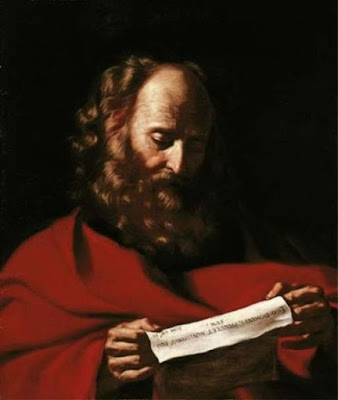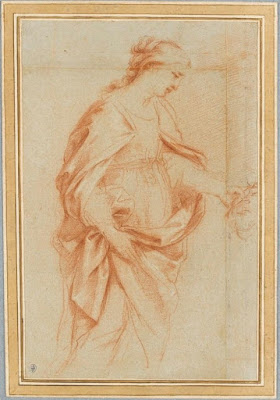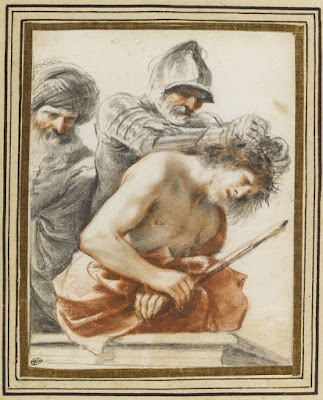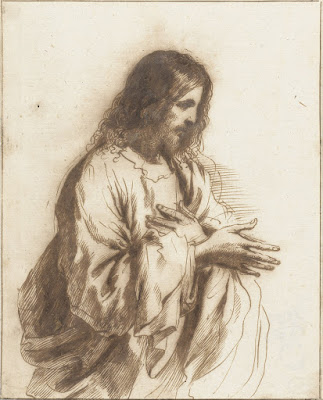 |
| Guercino (Giovanni Francesco Barbieri) Isaiah 1648 oil on canvas private collection |
 |
| Guercino (Giovanni Francesco Barbieri) Isaiah 1648 drawing (figure study) private collection |
"The painting is not mentioned by [Carlo Cesare] Malvasia, but is documented in the account book on 19 November 1648 as a 'testa dei Profeta Isaia' for the Marchese Cospi, which was subsequently 'mandato a Roma'. The price was 30 ducats (38 ½ scudi), which was Guercino's standard price for a half-length and thus too much for a picture of the current format. A possible explanation for this is that the picture has been cut down on all sides. A pen-and-ink drawing [directly above], formerly on the art market, may preserve the original composition, since it shows the same bald, profusely bearded prophet reading from a parchment held at an angle in both hands. In the extended design of the drawing, his left elbow rests on a large block, while the whole of his right arm is contrasted against a shaded background."
 |
| Guercino (Giovanni Francesco Barbieri) Freeing of Andromeda 1648 oil on canvas location unknown (formerly Doria Balbi Collection, Genoa) |
 |
| Guercino (Giovanni Francesco Barbieri) Freeing of Andromeda 1648 drawing (compositional study) private collection |
"Malvasia's description of the picture, under 1648, is as follows: 'Un Andromeda quadro grande al Commendatore Manzini'. A corresponding entry in the account book, dated 24 September 1648, records Giovanni Battista Manzini's payment for it in kind, with furniture and household items ('castellate, lo specchio'). Few of the painter's clients were allowed to settle their accounts in this way, but as one of his great friends, this was a privilege accorded to the Commendatore."
 |
| Guercino (Giovanni Francesco Barbieri) Venus burning Cupid's Bow and Arrows (lost painting) 1648 drawing (compositional study) private collection |
 |
| Guercino (Giovanni Francesco Barbieri) Erminia and the Shepherd 1648-49 oil on canvas Minneapolis Institute of Art |
 |
| follower of Guercino Erminia and the Shepherd (copy of Erminia figure) after 1649 oil on canvas Museo Civico, Modena |
 |
| Guercino (Giovanni Francesco Barbieri) Erminia and the Shepherd 1648-49 drawing (figure study - Erminia) National Gallery of Art, Washington DC |
 |
| Guglielmo Morghen after Guercino Erminia and the Shepherd ca. 1780 etching and engraving Philadelphia Museum of Art |
"Malvasia recorded this picture, 'Erminia col pastore che tesse fischelle ... quadro grande', as completed in 1649 for Antonio Ruffo of Messina, who had ordered the painting the previous summer. In a letter dated 1 August 1648, Guercino told Ruffo that he was in the process of completing the painting for him, but he wrote to him again on 4 November 1648, with excuses for the delay, saying he was being pressed to finish another large canvas and could not possibly complete Ruffo's work on time. What Guercino did not reveal was that the newly installed Bolognese papal legate, Cardinal Fabrizio Savelli (1607-59), also a renowned art collector, had seen the unfinished canvas of Erminia in the artist's studio and insisted on acquiring it. Guercino gave in, but was then obliged to produce a second version for Ruffo. [Savelli's version is now considered lost, while the surviving version in Minneapolis is believed to be the one belatedly painted for Ruffo.]"
– quoted texts from The Paintings of Guercino: a revised and expanded catalogue raisonné by Nicholas Turner (Rome: Ugo Bozzi Editore, 2017)
 |
| Guercino (Giovanni Francesco Barbieri) Marriage of the Virgin 1649 oil on canvas Fondazione Cassa di Risparmio, Fano |
 |
| Guercino (Giovanni Francesco Barbieri) Marriage of the Virgin 1649 drawing (drapery study-Virgin) (extended by a later hand) Staatsgalerie, Stuttgart |
 |
| Guercino (Giovanni Francesco Barbieri) Marriage of the Virgin 1649 drawing (drapery study - Joseph) Staatsgalerie, Stuttgart |
 |
| Guercino (Giovanni Francesco Barbieri) Marriage of the Virgin 1649 drawing (drapery study - Joseph) Staatsgalerie, Stuttgart |
 |
| Luigi Cunego after Guercino Marriage of the Virgin 1785 etching and engraving British Museum |
 |
| Guercino (Giovanni Francesco Barbieri) St Joseph 1649 oil on canvas Pinacoteca Nazionale di Bologna |
– quoted texts from The Paintings of Guercino: a revised and expanded catalogue raisonné by Nicholas Turner (Rome: Ugo Bozzi Editore, 2017)













































